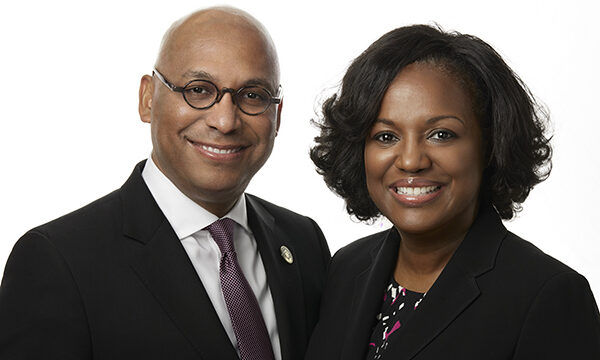What is “Christian,” and who defines it?

Over the Easter weekend, Adventist ReviewOnline and you celebrated Jesus’ resurrection together. But as you know, that was far from the end of the story. AR now offers you a special online series of articles to enable our reflection on the 50-day period leading from Jesus’ resurrection to the glorious day of Pentecost, when in dramatic fulfillment of Jesus’ own promise, His followers received the baptism of the Holy Spirit. That anointing empowered a handful of men and women to take the gospel to their entire world in a single generation. May you be inspired as you read.—Editors.
Did you know that 10 percent of American Seventh-day Adventists define their marital status as “living with a partner”? They told this to the Pew Forum on Religion and Public Life when it conducted its U.S. Religious Landscape Survey.1 Pew researchers think of Seventh-day Adventists as part of the subcategory “Protestant,” and their “living with a partner” percentage was the highest within that bracket. “Protestant” itself is, of course, part of the major religious category “Christian.” I say “of course,” though I also wonder—what is “Christian,” and who defines it?
The “Christian” Idea
“Christianity, as its name suggests, is primarily about Christ.”2 And the Christ who gives His name to Christianity bears it in acknowledgment of the fact that He is God’s anointed one (Acts 10:38).3 Those who first accepted Him as anointed report the anointing as a visible experience that transpired at a specific place, the river Jordan, during a particular event: His baptism by preacher John, the baptizer (Matt. 3:13-17). Further, they document His being tortured to death, only to emerge alive from His burial place three days later, in fulfillment of all the relevant Old Testament prophecies (Matt. 28:5-9; Luke 23:55, 56; 24:1-8, 13-27). This anointed, miracle-working, crucified, and resurrected Man, qualified by His experiences, is God’s means and agent of human deliverance from moral and every other crisis, and so to be proclaimed (Acts 10:38-43). Moreover, God has appointed Him judge and arbiter of all human destinies, both of the living and the dead (John 5:25-29).
The phenomenon of Christianity does not arise, like political platforms, association bylaws, or national constitutions, out of any collective deliberation that articulates a group’s most appropriate, organized approach or response to a given historical or crisis situation. Christianity is not Christianity because of church councils through the centuries and millennia. Appeals to hoary or recent tradition hold zero validation as Christian except they stand the test of the first-century documentation of the story of the Man who bore and bears the label Christ. Christianity is only truly Christian because it is like Christ. It is neither Christian because of a rhetoric of legacy, nor a coherence with Greek or other philosophy, nor because of the fascination of cutting-edge novelty. It is Christian because it declares again what and who the Anointed One Himself declared in His life and death, that which entitles Him to the label Anointed.
Birthday for Christianity
After He had shown Himself to be incarnate deity by His resurrection (Rom. 1:4), He returned to glory in heaven from the place of His passion and suffering, leaving more than one documented promise to come back for those who believe in Him (John 14:1-3; Acts 1:11). Fifty days later, crowds from the Jewish Diaspora gaped in amazement as Peter, a recently famous coward, confronted them with a denunciation for murder, by crucifixion, of God’s Son. But they could be absolved, he said, absolved of that crime and every other source of guilt. For the One whom they had crucified had burst death’s cords and gravity’s bonds, and soared to glory where He now sat enthroned at God’s right hand, as Lord and Christ, ready to pour down on Israel repentance and forgiveness of sins (Acts 2:36; 5:30, 31). “Repent,” the emboldened wimp commanded, “be baptized in the name of Jesus Christ for the forgiveness of your sins; and you will receive the gift of the Holy Spirit” (Acts 2:38).4 That day of miraculous conversions was Christianity’s dramatic public beginning.
The movement that would be called Christianity continued its advance with a miraculous healing at the Jerusalem Temple’s Gate Beautiful. Its proponents’ focus on Jesus Christ is unmistakable: “I do not possess silver and gold,” our former coward advised a maimed beggar, “but what I do have I give to you: In the name of Jesus Christ the Nazarene—walk!” (Acts 3:6). The walking, leaping, cavorting, nameless former cripple, and the bold, now unstoppable wimp were an embarrassment and astonishment to the political authorities. The prancing, praising, former cripple had never walked since birth. And the bold, miracle-working Peter had either been in a garden bawling for shame in the night alone, or else shut up in a house with other cowards hiding from them only two months before. The only explanation they could accept for his transformation was the impact on his life and person of the Man whom he claimed was now in heaven (Acts 4:13).
Still, the Jewish leaders could not allow these miracles: it would reflect poorly on their denial of the resurrection from the dead (verse 2). The Temple priests, at any rate, as members of Judea’s Hellenized minority party of Sadducees, were hostile to this doctrine (Matt. 22:23; Mark 12:18; Acts 23:8), even though the Pharisees, their partners in crucifixion crime, were not. Notably here, the record mentions the former, not the latter, as setting out to harass Peter and John (Acts 4:1, 2). Years later the Pharisees, diligent students of the Scriptures and believers in angels, spirits, and the resurrection, rise to support and defend Paul against the Sadducees, because they share his faith in the supernatural (Acts 23:6-10).
Title for Christianity
Down the road in time, and up the Mediterranean coast, at Antioch, followers of the resurrected Man who taught “the way of God in truth” (Matt. 22:16; Mark 12:14), and called Himself “the way” (John 14:6), would come to be stuck with the “anointed” label. They would come to be called “Christian.” The moniker would be attached to a group of people receiving the gospel among the city’s Hellenic population. Unapologetic, open-minded, aggressive, and sustained gospel preaching was converting huge numbers of idolatrous, Zeus-worshipping heathen (Acts 11:19-21). People driven out of their houses by persecution—beheading and stoning in Jerusalem—for believing in the Anointed One had come north up the coast to their city. But the persecuted had not come to hide. They had come to preach what Herod and the Sadducees couldn’t stand in Jerusalem. And as they preached, multitudes of worldly-minded Greeks were giving up their faith in Caesar and Plato, and bowing to the absolute authority over their lives: a Jewish Man crucified as a criminal, whom persecuted people from Jerusalem claimed to be God’s Anointed.
Aristides is Christianity’s earliest known postbiblical defender. He testifies about the power of the gospel, as well as about application of the name Christian. Concerning the power of gospel truth, Aristides writes of the Incarnation: “This is taught in the gospel . . . ; and you also if you will read therein may perceive the power which belongs to it.”5 Against today’s cringing apology for the weakness of the gospel before New York’s materialism, or California’s narcissism, or India’s mysticism, or Tibet’s Buddhism, Aristides contends that there is no way of missing the gospel’s power. Read for yourself and you see it. Its power is unmistakable. And as to the application of the name: “Thereupon these twelve disciples went forth throughout the known parts of the world, and kept showing his greatness with all modesty and uprightness. And hence also those of the present day [c. A.D. 125-147] who believe that preaching are called Christians.”6 The title does not appear to have been chosen any more than the message itself was negotiated. The message comes straight from Jesus. The message is Jesus the Christ. And the label comes from observers. From observers who could see that the preachers and their message were one and the same, and resolved to call them “Christies.”
The sticker may well have been unflattering because it was imposed, requiring a translation in the passive voice (“were . . . called Christians,” verse 26); and it was also new, linguistically Greek, originating, no doubt, from outside the company of Palestinian Aramaic speakers who brought the gospel to the city. They had not thought up any name for themselves. They had no time to pause to address issues of identity. Their message was everything. They were Christ’s disciples—His followers and students. And they were His apostles—His commissioned and sent. Objective and cynical observers had once contemptuously labeled them Galileans (Acts 2:7). But now, in Antioch, their new Greek brothers and sisters inspire more inventive scorn from Antioch’s wits, who compose a term in the Greek tongue with Latin morphology that outlasts any intended contempt and the millennia of history’s ebb and flow. So that today we may know what is Christian, and who defines it.
Who Defines Christian?
Clearly, the answer is Jesus Himself. Acts 11:19-26 shows that when Jesus is preached, the heathen recognize Him not only in the message but also in the messengers. As multitudes believe and turn to the Lord, Barnabas, Spirit-gifted (Acts 13:1), Spirit-filled (Acts 11:24), the encourager (Acts 4:36), comes to keep the cause advancing and the numbers spiritually growing. He comes and sees himself that God is at work, he sees “the grace of God” (Acts 11:23), he is thrilled and leaves to find reinforcements for this work. Many more come in (verse 24). The work continues through the year (verse 26). And the heathen looking on see that this is unlike anything they have ever seen before. They must label it. But it requires a new label. So they call them Christians, the product, and consequence, and reproduction of the Christ, the Anointed One who is the message they preach. Jesus, whom they preached, had done a total job of putting out the message. And they who preached Him did an unmistakable job of proclaiming, by word and witness of life, the truth of the message. And the heathen who beheld could not themselves miss the message.
After Jesus Himself, there is no need for further definition of “Christian.” “Christian” is not so because sociologists apply it as a label. Nor is it so because interviewees so self-identify. Jesus, recorded and reported in the Word, Jesus, reproduced in the witness of word and life among His followers—that is Christian. “Christian” has no further need of definition.
________
1 http://religions.pewforum.org/pdf/report-religious-landscape-study-full.pdf, © 2008 Pew Research Center. The actual question was: “Are you currently married, living with a partner, divorced, separated, widowed, or have you never been married?” See p. 73, “Marital Status by Protestant Denomination.”
2 A declaration all the more significant because its author is an evolutionist—Karl W. Giberson, Saving Darwin: How to Be a Christian and Believe in Evolution (New York: HarperOne, 2008), p. 11.
3 Christos in Greek, transliterated Christ, and equivalent to the Hebrew mashiach that gives us Messiah.
4 Scripture quotations are from the New American Standard Bible, copyright © 1960, 1962, 1963, 1968, 1971, 1972, 1973, 1975, 1977, 1995 by The Lockman Foundation. Used by permission.
5 “The Apology of Aristides the Philosopher,” in William Edgar and K. Scott Oliphint, eds., Christian Apologetics Past and Present: A Primary Source Reader (Wheaton, Ill.: Crossway, 2009), vol. 1, p. 31.
6 Ibid.
__________
This article was originally published October 11, 2012, in Adventist Review.
_______________________
Read more in our Days to Pentecost series:
- “Into the Highest Heaven” by Cliff Goldstein: https://www.adventistworld.org/into-the-highest-heaven/
- “Going Seismic” by Gary Swanson: https://www.adventistworld.org/going-seismic/
- “Breaking Down Barriers” by James H. Park: https://www.adventistworld.org/breaking-down-barriers/








